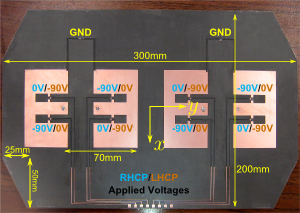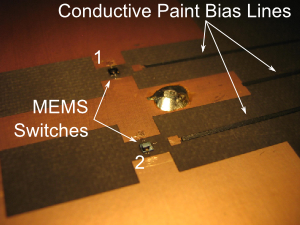
This 1×4 array has 4 antenna elements that can switch between RHCP and LHCP, enabling the support of many CP technologies using different polarizations
I am excited to announce my latest journal paper entitled “Design and Implementation of Broadband MEMS RHCP/LHCP Reconfigurable Arrays Using Rotated E-Shaped Patch Elements” with co-authors Harish Rajagopalan and Yahya Rahmat-Samii. This paper describes our development of a wideband antenna design that can switch between right-handed and left-handed circular polarization states, increasing the antenna flexibility for remote terminal applications. Our design used the E-shaped patch antenna to obtain wide bandwidth and incorporated MEMS switches to achieve the reconfiguration. Our single element design was able to achieve nearly double the bandwidth of current state-of-the-art. We continued to develop and fabricate a 1×4 antenna array design as seen in the figure to the right.

Magnified view of the commercial MEMS switches incorporated into the CP E-shaped patch antenna design
Integrating the MEMS switches was not an easy task. We conducted in-depth studies to find the most appropriate MEMS switch model to incorporate into the simulation software. It was important for our model to nicely balance accuracy and simulation speed, and we found a good circuit model which provides this balance. The speed is important when optimizing the antenna design; a typical optimization run can test anywhere from 1,000-20,000 different designs. Providing a bias voltage for the switches is another problem often encountered in this arena. For our particular design, the performance was highly sensitive to any metal placed in the vicinity of the patch antenna because of the strong field concentrations around the patch antenna. To surmount this difficulty, we opted for conductive paint bias lines with a low conductivity to provide the required voltages. These conductive paint bias lines are illustrated in the rightward photo. The low conductivity of the paint leads to negligible interactions with the antenna, and the MEMS switches require very little current, leading to an compact, efficient approach.
For more information, the journal paper can be found on IEEEXplore at this link.
